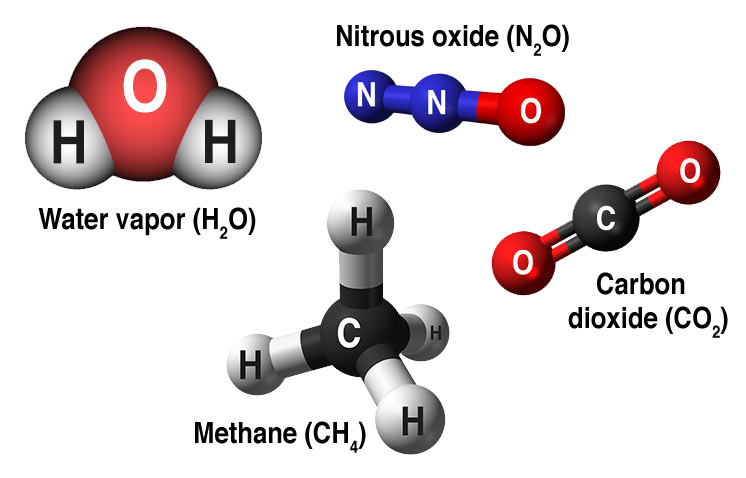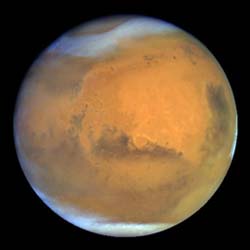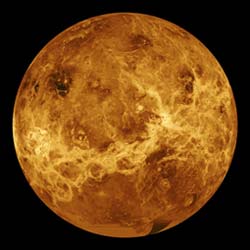what are the most likely changes to atmospheric temperature and precipitation
› en español
Scientists attribute the global warming trend observed since the mid-xxth century to the human expansion of the "greenhouse effect" 1 — warming that results when the temper traps heat radiating from Globe toward space.
Certain gases in the atmosphere cake heat from escaping. Long-lived gases that remain semi-permanently in the atmosphere and do not respond physically or chemically to changes in temperature are described as "forcing" climate alter. Gases, such equally water vapor, which answer physically or chemically to changes in temperature are seen as "feedbacks."
Gases that contribute to the greenhouse effect include:

- Water vapor. The almost abundant greenhouse gas, but chiefly, it acts as a feedback to the climate. Water vapor increases every bit the Globe'south atmosphere warms, only so does the possibility of clouds and precipitation, making these some of the most important feedback mechanisms to the greenhouse upshot.
- Carbon dioxide (CO2). A minor but very important component of the temper, carbon dioxide is released through natural processes such as respiration and volcano eruptions and through human activities such equally deforestation, land use changes, and called-for fossil fuels. Humans have increased atmospheric COtwo concentration by 48% since the Industrial Revolution began. This is the most of import long-lived "forcing" of climate change.
- Methane. A hydrocarbon gas produced both through natural sources and human being activities, including the decomposition of wastes in landfills, agriculture, and especially rice tillage, also as ruminant digestion and manure management associated with domestic livestock. On a molecule-for-molecule basis, methane is a far more than active greenhouse gas than carbon dioxide, simply also one which is much less abundant in the temper.
- Nitrous oxide. A powerful greenhouse gas produced past soil tillage practices, especially the use of commercial and organic fertilizers, fossil fuel combustion, nitric acid production, and biomass called-for.
- Chlorofluorocarbons (CFCs). Synthetic compounds entirely of industrial origin used in a number of applications, but now largely regulated in production and release to the temper by international understanding for their ability to contribute to destruction of the ozone layer. They are too greenhouse gases.


On Earth, human being activities are changing the natural greenhouse. Over the final century the burning of fossil fuels like coal and oil has increased the concentration of atmospheric carbon dioxide (CO2). This happens considering the coal or oil burning process combines carbon with oxygen in the air to make COtwo. To a bottom extent, the immigration of land for agriculture, industry, and other human activities has increased concentrations of greenhouse gases.
The consequences of changing the natural atmospheric greenhouse are hard to predict, but some effects seem likely:
- On boilerplate, Earth will become warmer. Some regions may welcome warmer temperatures, merely others may not.
- Warmer conditions will probably lead to more evaporation and atmospheric precipitation overall, but individual regions volition vary, some becoming wetter and others dryer.
- A stronger greenhouse issue volition warm the body of water and partially melt glaciers and ice sheets, increasing sea level. Ocean water also volition expand if it warms, contributing farther to body of water level rise.
-
Outside of a greenhouse, college atmospheric carbon dioxide (COtwo) levels tin can have both positive and negative effects on ingather yields. Some laboratory experiments suggest that elevated CO2 levels can increase plant growth. However, other factors, such every bit changing temperatures, ozone, and water and nutrient constraints, may more than counteract whatever potential increase in yield. If optimal temperature ranges for some crops are exceeded, earlier possible gains in yield may be reduced or reversed birthday.
Climate extremes, such every bit droughts, floods and extreme temperatures, tin can atomic number 82 to ingather losses and threaten the livelihoods of agricultural producers and the nutrient security of communities worldwide. Depending on the ingather and ecosystem, weeds, pests, and fungi can also thrive nether warmer temperatures, wetter climates, and increased COtwo levels, and climate change will likely increase weeds and pests.
Finally, although rising CO2 can stimulate plant growth, enquiry has shown that it can also reduce the nutritional value of most food crops by reducing the concentrations of protein and essential minerals in most institute species. Climate change can cause new patterns of pests and diseases to sally, affecting plants, animals and humans, and posing new risks for food security, food safety and human health. two
The Role of Man Activity
In its Fifth Cess Written report, the Intergovernmental Panel on Climate Change, a group of 1,300 contained scientific experts from countries all over the world under the auspices of the United Nations, concluded there's a more 95 per centum probability that human activities over the past fifty years have warmed our planet.
The industrial activities that our modern culture depends upon have raised atmospheric carbon dioxide levels from 280 parts per one thousand thousand to about 417 parts per one thousand thousand in the last 151 years. The panel besides concluded there's a amend than 95 per centum probability that human-produced greenhouse gases such as carbon dioxide, marsh gas and nitrous oxide have acquired much of the observed increase in Earth'south temperatures over the past l-plus years.
The console's full Summary for Policymakers written report is online at https://world wide web.ipcc.ch/site/assets/uploads/2018/02/ipcc_wg3_ar5_summary-for-policymakers.pdf.
Solar Irradiance
The amount of solar energy that World receives has followed the Sunday'southward natural eleven-year cycle of small ups and downs with no internet increase since the 1950s. Over the aforementioned flow, global temperature has risen markedly. Information technology is therefore extremely unlikely that the Sun has acquired the observed global temperature warming tendency over the by half-century. Credit: NASA/JPL-Caltech
It's reasonable to assume that changes in the Sun's energy output would cause the climate to modify, since the Dominicus is the fundamental source of free energy that drives our climate organization.
Indeed, studies show that solar variability has played a function in past climate changes. For example, a decrease in solar activity coupled with an increase in volcanic activity is thought to have helped trigger the Little Ice Age between approximately 1650 and 1850, when Greenland cooled from 1410 to the 1720s and glaciers avant-garde in the Alps.
But several lines of evidence show that current global warming cannot be explained by changes in free energy from the Lord's day:
- Since 1750, the average amount of free energy coming from the Dominicus either remained constant or increased slightly.
- If the warming were caused past a more active Sunday, then scientists would expect to come across warmer temperatures in all layers of the atmosphere. Instead, they have observed a cooling in the upper atmosphere, and a warming at the surface and in the lower parts of the atmosphere. That's because greenhouse gases are trapping heat in the lower atmosphere.
- Climate models that include solar irradiance changes can't reproduce the observed temperature trend over the past century or more without including a rise in greenhouse gases.
References
-
IPCC Fifth Assessment Written report, 2014
United States Global Modify Research Program, "Global Climate Change Impacts in the United states of america," Cambridge University Press, 2009
Naomi Oreskes, "The Scientific Consensus on Climate Change," Science 3 December 2004: Vol. 306 no. 5702 p. 1686 DOI: ten.1126/science.1103618
-
U.S. Ecology Protection Agency: "Climate Impacts on Agriculture and Food Supply"
-
Mike Lockwood, "Solar Change and Climate: an update in the light of the current infrequent solar minimum," Proceedings of the Royal Society A, 2 December 2009, doi 10.1098/rspa.2009.0519;
Judith Lean, "Cycles and trends in solar irradiance and climate," Wiley Interdisciplinary Reviews: Climate Change, vol. 1, January/Feb 2010, 111-122.
Source: https://climate.nasa.gov/causes/
0 Response to "what are the most likely changes to atmospheric temperature and precipitation"
Post a Comment